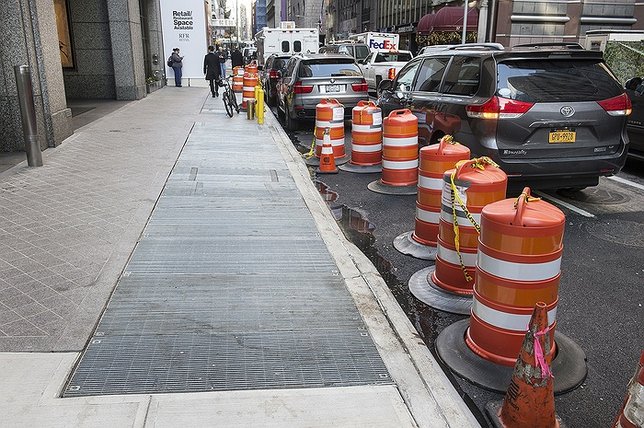New York, NY - December 7, 2015 - The Metropolitan Transportation Authority (MTA) today announced the substantial completion of two significant contracts on East Side Access, the megaproject that will bring Long Island Rail Road service to Grand Central Terminal. Workers have completed construction of a subterranean ventilation facility below East 55th Street in Manhattan, and $56.2 million in infrastructure improvements to Harold Interlocking, in Sunnyside, Queens, the busiest passenger train junction in the United States and the place where the tracks for the connection to Grand Central will meet with the Long Island Rail Road.
“The completion of these two contracts underscores the magnitude of the behind-the-scenes work that must take place for East Side Access to function,” said Dr. Michael Horodniceanu, President of MTA Capital Construction. “Most of the work has been going on outside of public view, spanning Manhattan and Queens. Even when the project is completed, the new infrastructure will remain largely out of sight. But it is nonetheless critically important for the project. You can’t have LIRR service to Grand Central without the components we’ve just finished building.”
East 55th Street Ventilation Facility
Construction of the ventilation facility began in November 2012. It was built beneath the roadway of 55th Street between Park and Madison Avenues and will provide ventilation for the tunnels under Park Avenue that will carry LIRR trains to Grand Central.
To allow the construction of the facility below the surface to take place, the street had to be closed temporarily over the course of several weekends early on in the contract so a steel deck could be installed. This steel deck allowed the contractor to excavate and work safely below ground while traffic continued to flow above.
Under the steel deck, workers safely executed 144 controlled blasts that, along with mechanical excavation, removed 10,000 cubic yards of rock and soil – or enough to fill three Olympic-sized swimming pools – to create space that provides a pathway for the air to flow to and from the tunnels below.
The facility extends 150 feet below street level, but is entirely hidden from view on the street, with the exception of an emergency hatch and ventilation grates in the sidewalk. In order to be easier to navigate for those wearing high-heeled shoes, the sidewalk “high-heel friendly” grates are made with slip-resistant surfaces and the openings between the cross-bars are only ½ inch wide.
The ventilation facility was built by a joint venture of the Schiavone Construction Co. and John P. Picone, Inc., at a cost of $57.5 million. It is one of four ventilation facilities being built in Manhattan for East Side Access.
Just blocks away, two components of East Side Access are already bringing benefits to the public. Fifteen months ago the megaproject opened 50th Street Commons, a comfortable vest pocket park between Park and Madison Avenues. Eleven months before that, the MTA opened a new entrance to Grand Central inside 245 Park Avenue that faces 47th Street between Park and Lexington Avenues. The entrance is now the most direct way to access Grand Central’s platforms from points east of Lexington Avenue and north of 47th Street.
Queens Infrastructure Upgrades
The work just completed in Queens began in August 2009 and was performed by Tutor Perini Corp. Through this contract, workers made a variety of infrastructure improvements within Harold Interlocking that will allow for an increase in capacity and improved train operations.
Harold Interlocking, already the busiest passenger railroad switching complex in the country, governs the movement of four railroads between Penn Station, Long Island, New England, and Sunnyside Yard, where Amtrak and NJ Transit store trains. Adding a connection to Grand Central, while creating dedicated new tracks above and below it to reduce congestion-related delays, requires the installation of nearly one hundred new switches and miles of new track.
That work is already underway, but the work being done by the just-completed Perini contract will enable it to reach its conclusion. Under this contract, workers built numerous retaining walls; 2,700 feet of new storm sewer; 3,600 feet of duct banks that house 12,000-volt AC traction power, an access road, and five utility conduits known as microtunnels that have a diameter of about five feet. They installed three electrical substations for snow melters, which keep track switches operable year-round by preventing ice and snow buildup. They relocated and adjusted utility conduits, installed an electronic device governing information distribution that is composed of microprocessors known as a remote terminal unit. They purchased three gantries that will bear overhead train signals.
East Side Access is the largest transportation infrastructure construction project in the country. When it opens for passenger service, which the MTA forecasts will take place in 2022, it will serve an expected 162,000 LIRR customers every day at a new station being built under Grand Central. The project will double the LIRR’s capacity to bring trains into Manhattan and allow Metro-North Railroad’s New Haven Line to access Penn Station via four stations that will be built in the Bronx. It is the most transformative project for New York’s railroad network since the Pennsylvania Railroad built a total of six tunnels under the East and Hudson Rivers and inaugurated train service to Pennsylvania Station, in 1910.










